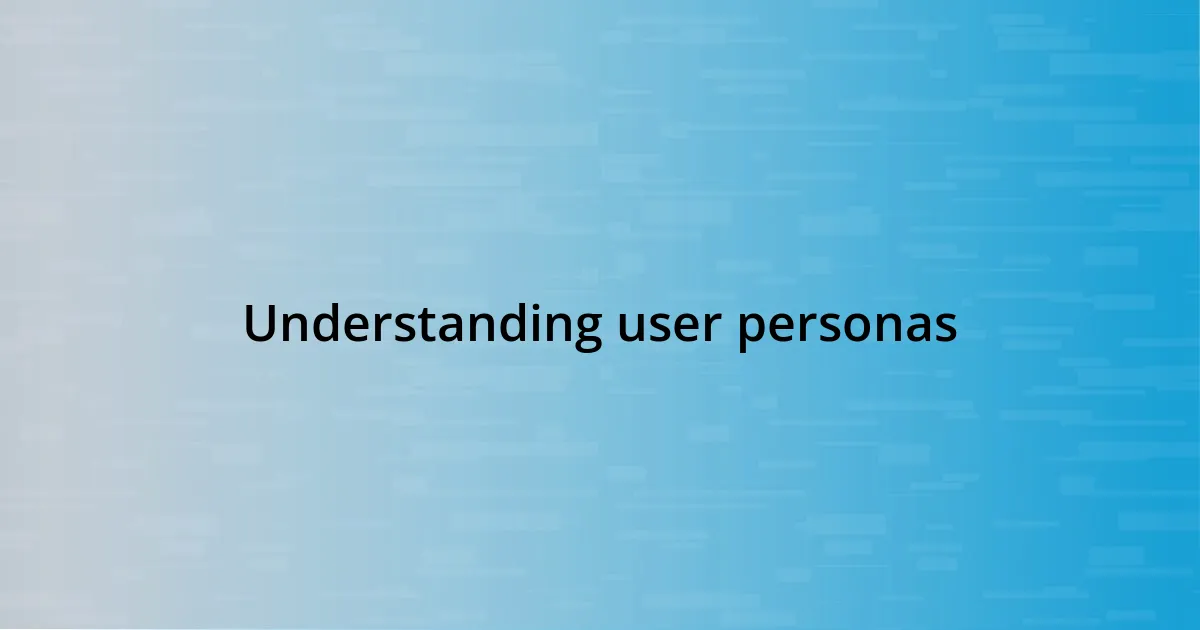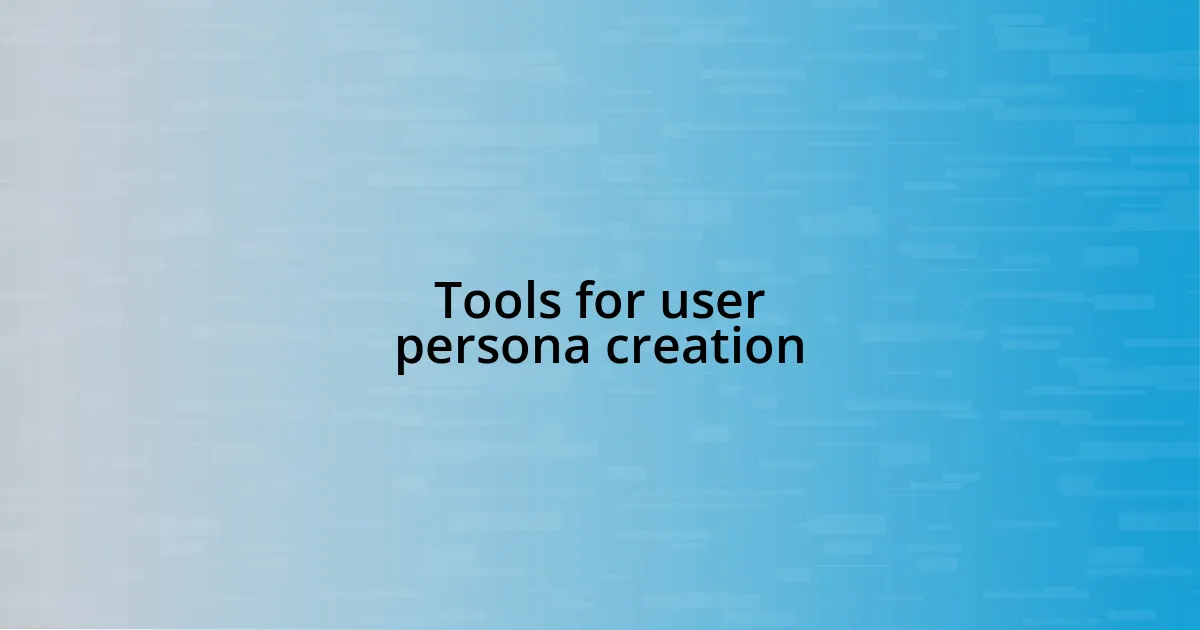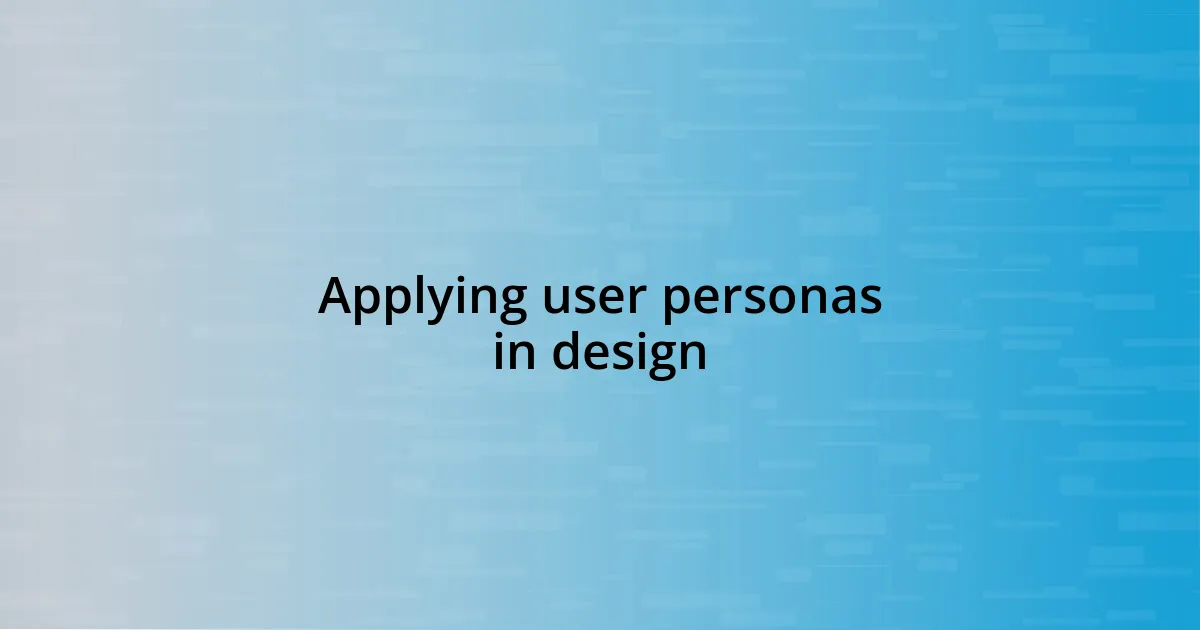Key takeaways:
- User personas, derived from data analysis and user stories, bridge the gap between design and real user needs, enhancing empathy and guiding focused decisions.
- Creating user personas involves gathering data, distilling insights into actionable personas, and continuously validating them based on user feedback and evolving needs.
- Effective tools like Xtensio, UserForge, and Miro facilitate the persona creation and collaboration process, turning complex data into relatable stories.
- Applying user personas in design fosters team alignment and drives design choices that resonate emotionally with users, enhancing overall user experience.

Understanding user personas
User personas are essentially fictional characters created through data analysis and research that represent the different user types within a targeted demographic. When I first dived into persona creation, I remember feeling overwhelmed by the amount of information available. It felt like trying to piece together a puzzle without knowing what the final picture should look like. Isn’t it fascinating how a collection of data can come together to form a clearer image of who we are designing for?
Creating user personas has been one of the most eye-opening experiences in my professional journey. I recall crafting a persona for a project aimed at young mothers. I spoke with several of them, and their stories—filled with joy and challenges—really brought the persona to life for me. It made me wonder: how often do we forget to truly listen to the people we’re designing for? That emotional connection can turn a simple document into a powerful tool that guides our design decisions.
As I developed deeper insights into user personas, I found that they serve as a bridge between our designs and real user needs. Each persona embodies unique traits and experiences that help the team stay focused and empathetic. I often ask myself, “How would this persona use my product?” The answer not only guides functionality but also ignites creativity, pushing me to design with intention and purpose.

Importance of user personas
Understanding the importance of user personas is crucial for any design process. They transcend mere demographics, providing a richer understanding of user motivations and challenges. I remember a time when I had initially overlooked this aspect in a project, only to realize later that my designs missed the mark. It was a humbling experience, reminding me that empathy is at the heart of effective design.
Here are some key reasons why user personas matter:
- Guidance for Decision-Making: They act as a reference point, helping teams make design choices that resonate with real users.
- Enhance Empathy: By humanizing data, personas allow us to step into our users’ shoes, fostering empathy throughout the design.
- Focus Collaboration: They enable clearer communication among team members, as everyone aligns around a shared understanding of user needs.
- Prioritize Features: Personas help prioritize which features will deliver the most value to the target audience, streamlining the design process.
- Improve Marketing Strategies: They also inform marketing campaigns, ensuring messages are tailored to specific user segments.
Reflecting on my experiences, using personas has often brought clarity amidst the chaos. Once, while developing a feature for older adults, mapping out their daily challenges illuminated new pathways for design. This not only transformed the feature but also deepened my perspective on user needs. That revelation made me excited about the potential that well-crafted personas can unlock in creating meaningful user experiences.

Steps for creating user personas
Creating user personas is a structured yet flexible process that can significantly enhance your design work. The first step I recommend is gathering data through interviews, surveys, or observations. When I embarked on this journey, I was surprised by how rich qualitative insights could emerge from just a few conversations. Listening to users directly opened my eyes to their real-world experiences and needs, making the persona creation less abstract and more relatable.
Next, distilling that information into concise personas is essential. I remember sitting down at my desk, surrounded by sticky notes filled with quotes from users. It was a daunting task to condense their stories into specific characteristics, motivations, and frustrations. But doing so allows you to focus clearly on the essential traits that drive user behavior. This refining process was a revelation; by prioritizing key elements, I could design products that truly resonated with the intended audience.
Finally, validating and iterating on your personas shouldn’t be overlooked. I often revisit my personas after testing concepts to ensure they still hold true. For instance, after launching a new app version, I made it a point to gather user feedback and adjust the personas accordingly. This step has taught me that user personas evolve just like the users themselves. By continuously refining them, you ensure they remain relevant and effective guides throughout your design process.
| Steps | Description |
|---|---|
| 1. Gather Data | Collect insights through user interviews, surveys, or observations. |
| 2. Distill Information | Synthesize the gathered data into concise, actionable personas. |
| 3. Validate and Iterate | Continuously refine personas based on user feedback and changes. |

Tools for user persona creation
When it comes to tools for user persona creation, I’ve found several that truly stand out. I often use Xtensio, which allows for the creation of visually appealing persona templates. The ease of dragging and dropping different elements makes formatting a breeze, and it lets me present my personas in a way that instantly captures the team’s attention. Have you ever struggled with how to present complex information clearly? I know I have, and it’s these tools that can turn overwhelming data into relatable stories.
Another handy tool is UserForge. It’s specifically designed for user persona development, guiding you through a structured process. I appreciate how it prompts you with questions that ensure I don’t miss any critical details. For example, I remember a project where diving deep into user motivations revealed features we had never considered. It’s fascinating how a simple prompt can open up new avenues of thought, don’t you think?
Lastly, I often turn to Miro for collaborative brainstorming sessions. This interactive whiteboard helps my team visualize and shape personas collectively. Each session feels like a workshop, where ideas flow freely, and it’s amazing how quickly those sparks of inspiration lead us to richer personas. The collective energy often culminates in personas that reflect a diverse range of insights. Have you had moments when collaboration transformed your understanding of a topic? Those instances remind me that the best ideas often come from a blend of perspectives.

Analyzing user persona data
Analyzing user persona data is where the real magic happens. When I sifted through the insights gathered from interviews, I felt like a detective piecing together a character’s backstory. The data transformed into vivid narratives, highlighting challenges and desires that surprised even me. It’s incredible how a few poignant quotes can crystallize complex emotions, shaping the way I approached design.
As I started categorizing the traits and behaviors, I realized this wasn’t just about demographics; it was about understanding what drives people. One exercise I found particularly enlightening was mapping out user journeys. I vividly remember placing myself in the users’ shoes, encountering obstacles that mirrored their frustrations. By doing so, I could anticipate needs and innovate solutions that felt personal, almost like crafting a tailored experience just for them. Have you ever experienced that “aha” moment when everything clicks into place? That’s the beauty of analyzing such data—those moments feel profoundly fulfilling.
Validation is a crucial step in this process. I often revisit my personas, and I can’t help but feel a mix of nostalgia and excitement when I check their relevance. After every launch, I dive back into the feedback, and those real-life reactions fuel my desire to iterate. It’s a constant reminder that our work can evolve, just like the people we’re creating for. How do you ensure your personas reflect real users? For me, it’s all about staying curious and open to change, nurturing a dynamic relationship between the user and the persona that guides my design journey.

Applying user personas in design
One of the most rewarding parts of applying user personas in design is the alignment it brings to the team. I remember a project where we were all going in different directions until we presented our user personas. Suddenly, it felt like we were all looking at the same map that led us to a common destination. Have you ever experienced a team breakthrough like that? It’s astounding how a well-defined persona can provide clarity and focus, guiding design decisions and ensuring that every element serves a purpose that resonates with users.
As I implemented design changes based on these personas, I often found myself reflecting on their narratives. For instance, when redesigning a feature for an older demographic, I recalled a persona that highlighted their comfort with technology—or, often, their discomfort. I vividly remember advocating for larger buttons and clearer labels after researching their feedback. This wasn’t just about aesthetics; it was about crafting an experience that acknowledged their unique challenges. Has there ever been a moment in your work where understanding a persona shifted your entire design strategy? Those moments are what I cherish most.
Further, I incorporated storytelling into our design process, a tactic brought to life by the user personas. I once led a brainstorming session where we shared user stories—vivid accounts that made the personas not just fictional characters but real people with hopes and frustrations. This narrative approach made discussions richer, sparking compassion and creativity among team members. It’s fascinating how such stories can push designs beyond just satisfying functional needs, transforming them into experiences that resonate emotionally. Have you felt that connection between storytelling and design impact? It’s often the spark that leads to innovation.














